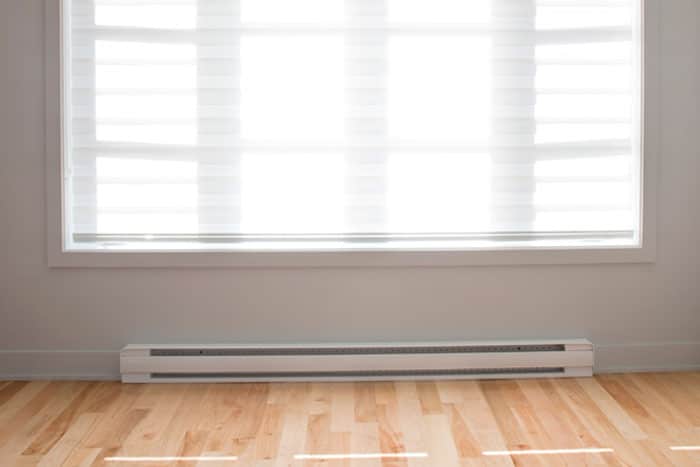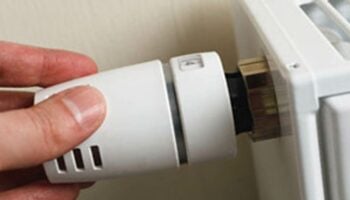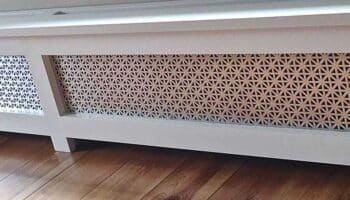We've independently reviewed this article to make sure it's as accurate as we can make it.
To find out more about our article creation and review process, check out our editorial guidelines.
Are you stuck trying to turn off your electric or hot water baseboard heater?
Unfortunately, baseboard heaters, just like any other electronic device, are prone to fail. I know how annoying it can be to have this happen, especially when you paid a hefty sum for it.

If your baseboard heater won’t turn off, you’ll need to check your thermostat and check valve because they may be damaged. But, don’t worry, keep reading to learn how to solve this issue and turn off your baseboard heater safely.
Before diving into how to turn the baseboard heaters off, let’s first examine the reasons why they are not turned off in the first place.
Why Your Baseboard Heaters Won’t Turn Off
#1 Broken thermostat
Normally, your baseboard heater is supposed to turn off automatically. However, if it keeps running even after attempting to turn it off, there’s a very good chance your thermostat is malfunctioning.
How can you tell if the thermostat is stuck? If you notice your electricity bills escalating or detect an inaccurate reading of the thermostat, it should be your first sign. Also, consider checking for a low battery notification.
These are 5 signs that indicate a thermostat problem:
- Heaters running at all times.
- The temperature of your room is not the same as what the thermostat is set to produce.
- Receiving a low battery notification.
- High electric bills.
- It has been a long time since you changed your thermostat, probably 8 to 12 years.
N/B: Whether your thermostat is stuck or has malfunctioned, resolve the issue by replacing it.
#2 Damaged check valve
While a faulty thermostat can cause the issue, a damaged check valve can also be the reason your baseboard heater is not turning off.
Check valves are one-way ports integrated into hot water systems. If the valve is damaged or old, it might keep your baseboard heater from turning off.
Fixing A Baseboard Heater That Won’t Turn Off
Replace the Thermostat
Consider replacing the old or broken thermostat. Since problems with a thermostat are the primary cause of your baseboard heater not turning off, the issue will easily be fixed if you replace your thermostat.
Follow these steps to replace your thermostat:
#1 Read the manual carefully.
Before doing anything else, I strongly recommend reading the manual of the thermostat that you’re going to install. This will provide you with clear guidelines for how to do the installation successfully.
#2 Turn off the power
Before removing the old thermostat, it is safe to shut off the power. There should be no electric current passing through at the time of removing the thermostat. If you fail to turn it off, you are at risk of being shocked.
#3 Remove the old thermostat.
The thermostat is held by a cover plate and screws. Use a screwdriver and unscrew the screws connecting the cover plates to the wall. After removing it, set it on the side. Proceed to unscrew the mounting screws connecting the thermostat to the wall. Pull it off and keep it aside; you will be left with exposed wires.
#4 Prepare the wires
After successfully removing the old thermostat, it is essential to prepare the wire ready for new installation.
But, how do you prepare the wires? Simple. You’ll just need to label the wires to ensure safe and successful installation. Assign a letter to each sticker and stick them on the respective wires.
After successfully arranging the wires, remove the thermostat base, which is still attached to the wall by this time.
#5 Install the new thermostat
The first step is installing the new base and running a low voltage wire that you prepared through the new baseplate.
While all bases are different, there will be an opening for clear wires. Besides, most of them have their base labeled with wire color, ensuring ease of connectivity.
Then, screw in the thermostat on the wall. Ensure they are firmly screwed appropriately to avoid being loose.
#6 Cover the thermostat
After firmly placing the thermostat, it’s time for us to attach the faceplate to cover the thermostat. You should be able to get them in a place where the old ones were attached.
Are you experiencing any trouble attaching the cover? You do not need a professional for that. Instead, try using drywall anchors. The purpose of covering the thermostat is to ensure it is not exposed to things like water, which can cause short-circuiting.
#7 Wrap up
Are there some terminals that you did not utilize? Avoid leaving them hanging and openly exposed. Instead, try to tack in back all the remaining wires back into the wall. But do leave plenty of slack incase you need to use a spare wire one day.
Program the thermostat as required and test if your baseboard heater can now go off.
How To Fix A Damaged Check Valve
A check valve is a tiny brass fitting coming out of your water heater. When a check valve becomes damaged, your baseboard heater can’t be turned off.
Luckily, this issue can be easily fixed. You’ll just need to replace the damaged check valve. Follow these quick steps to do it:
Follow these quick steps to replace the damaged check valve:
- Turn off the water and, using the drain plug, drain the water heater.
- Make sure that the hose attached to the check valve doesn’t have water.
- Remove the old check valve.
- Install the new check valve by screwing in a place where the old one was located.
- Reattach the hose pipe, turn on the water, and test if the baseboard heater will turn off.
- You may need to bleed out the air depending on the setup of your hot water heater.
Other Issues With Baseboard Heaters
Apart from the baseboard failure to turn off, there are different issues that one might encounter.
The circuit breaker of a baseboard heater trips
Short-circuiting is another problem that you might encounter when dealing with baseboard heaters. If the circuit breaker of the baseboard heater trips abruptly, you may be experiencing short-circuiting in the system.
This is typically a signal of a great underlying issue. If the circuit breaker continues to trip, I recommend you stop using the heater and contact a professional. The root cause of the trip may be a hazard.
How do you inspect your electrical system?
First, inspect the wire insulation connections in the baseboard heater. Check the wire that connects the electrical panel to the circuit breaker and the thermostat and if the wires are crushed, the insulation might be compromised, resulting in overheating.
How do you prolong the electrical system’s life span? Ensure the wires are unbroken and connect with the thermostat. The inspection should be done every year, preventing wear and tear.
The baseboard produces a burnt odor
This is another issue that you might experience when dealing with baseboard heaters, other than not turning them off.
Do you smell a burnt odor when the baseboard is running? Usually, the odor is from burnt lubricant and dust collected in the vent. Proper vent cleaning can help remedy the issue.
How do you check the baseboard heater? In case you notice a burnt odor while running, turn the heater off and wait for it to cool. Use a wet cloth to wipe off the dirt from the vent. Turn it on and if the odor persists, consult a technician.
How do you prevent bad odor from the baseboard heater? Ensure you clean the vent after using it to avoid dust build-up.
If the odor persists, it is best to change it completely. It is essential to ensure that carbon monoxide functions properly to avoid carbon poisoning, especially when the heater produces burnt odors.
Conclusion
In this article, we have examined two reasons why your baseboard heater won’t turn off. They include a broken thermostat and a damaged check valve.
These are problems that you can inspect and resolve yourself, as we have examined safe step-by-step processes of addressing the issues. However, if you are not feeling safe handling them, it is best to consult an electronic technician.
Also, as you address the issue of the baseboard heater not turning off, be on the lookout for possible problems that you might encounter, like failure to turn it on and other difficulties. I hope you have gained insight into avoiding issues with your baseboard heater and how to solve them when they occur.
Thank you for taking the time to read this article. Please don’t forget to check out our related content below!







